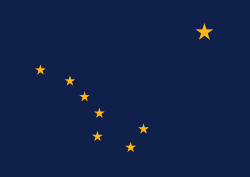Aleutian Islands campaign
The Aleutian Islands campaign was a military campaign conducted by the United States and Japan in the Aleutian Islands, part of the Territory of Alaska, in the American theater and the Pacific theater of World War II starting on 3 June 1942.[3] In the only two invasions of the United States during the war, a small Japanese force occupied the islands of Attu and Kiska, where the remoteness of the islands and the challenges of weather and terrain delayed a larger U.S.-Canadian force sent to eject them for nearly a year. The islands' strategic value was their ability to control Pacific transportation routes, which is why U.S. General Billy Mitchell stated to the U.S. Congress in 1935, "I believe that in the future, whoever holds Alaska will hold the world. I think it is the most important strategic place in the world."[4] The Japanese reasoned that control of the Aleutians would prevent a possible U.S. attack across the Northern Pacific. Similarly, the U.S. feared that the islands would be used as bases from which to carry out a full-scale aerial attack on U.S. West Coast cities like Anchorage, Seattle, San Francisco, or Los Angeles.
| Aleutian Islands campaign | |||||||
|---|---|---|---|---|---|---|---|
| Part of the American Theater and Pacific Theater of World War II | |||||||
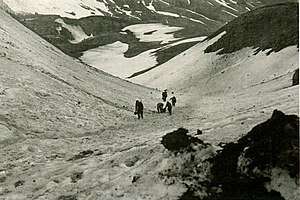 American troops hauling supplies on Attu in May 1943 through Jarmin pass. Their vehicles could not move across the island's rugged terrain. | |||||||
| |||||||
| Belligerents | |||||||
|
|
| ||||||
| Commanders and leaders | |||||||
|
|
| ||||||
| Strength | |||||||
| 144,000[1] | 8,500[1] | ||||||
| Casualties and losses | |||||||
|
1,481 killed US Navy vessels lost:
|
4,350 killed 28 captured 7 warships sunk 9 cargo transport ships sunk[1] | ||||||
| 2 civilians killed, 46 captured | |||||||
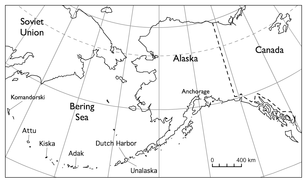
A battle to reclaim Attu was launched on May 11, 1943, and completed following a final Japanese banzai charge on May 29. On August 15, 1943, an invasion force landed on Kiska in the wake of a sustained three-week barrage, only to discover that the Japanese had withdrawn from the island on July 29.
The campaign is known as the "Forgotten Battle",[5] due to its being overshadowed by the simultaneous Guadalcanal Campaign[6] (7 August 1942 to 9 February 1943). Military historians believe it was a diversionary or feint attack during the Battle of Midway, meant to draw out the U.S. Pacific Fleet from Midway Atoll, as it was launched simultaneously under the same commander, Isoroku Yamamoto. Some historians have argued against this interpretation, believing that the Japanese invaded the Aleutians to protect their northern flank, and did not intend it as a diversion.[7]
Japanese attack
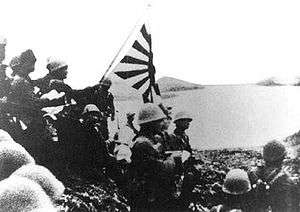
Before Japan entered World War II, its Navy had gathered extensive information about the Aleutians, but it had no up-to-date information regarding military developments on the islands. Admiral Isoroku Yamamoto provided the Japanese Northern Area Fleet, commanded by Vice-Admiral Boshiro Hosogaya, with a force of two non-fleet aircraft carriers, five cruisers, twelve destroyers, six submarines, and four troop transports, along with supporting auxiliary ships. With that force, Hosogaya was first to launch an air attack against Dutch Harbor, then follow with an amphibious attack upon the island of Adak, 480 miles (770 km) to the west. Hosogaya was instructed to destroy whatever American forces and facilities were found on Adak—the Japanese did not know the island was undefended. Hosogaya's troops were to return to their ships and become a reserve for two additional landings: the first on Kiska, 240 miles (390 km) west of Adak, the other on the Aleutians' westernmost island, Attu, 180 miles (290 km) west from Kiska.
Because United States Naval Intelligence had broken the Japanese naval codes, Admiral Chester Nimitz had learned by May 21 of Yamamoto's plans, including the Aleutian invasion, the strength of both Yamamoto's and Hosogaya's fleets, and that Hosogaya would open the fight on June 1 or shortly thereafter.
As of June 1, 1942, United States military strength in Alaska stood at 45,000 men, with about 13,000 at Cold Bay (Fort Randall) on the tip of the Alaskan Peninsula and at two Aleutian bases: the naval facility at Dutch Harbor on Unalaska Island, 200 miles (320 km) west of Cold Bay, and the recently built Fort Glenn Army Airfield 70 miles (110 km) west of the naval station on Umnak Island. Army strength, less air force personnel, at those three bases totaled no more than 2,300, composed mainly of infantry, field and antiaircraft artillery troops, and a large construction engineer contingent, which was used in the construction of bases. The Army Air Force's Eleventh Air Force consisted of 10 B-17 Flying Fortress heavy bombers and 34 B-18 Bolo medium bombers at Elmendorf Airfield, and 95 P-40 Warhawk fighters divided between Fort Randall AAF at Cold Bay and Fort Glenn AAF on Umnak. The naval commander was Rear Admiral Robert A. Theobald, commanding Task Force 8 afloat, who as Commander North Pacific Force (ComNorPac) reported to Admiral Nimitz in Hawaii. Task Force 8 consisted of five cruisers, thirteen destroyers, three tankers, six submarines, as well as naval aviation elements of Fleet Air Wing Four.[8]
When the first signs of a possible Japanese attack on the Aleutians were known, the Eleventh Air Force was ordered to send out reconnaissance aircraft to locate the Japanese fleet reported heading toward Dutch Harbor and attack it with bombers, concentrating on sinking Hosogaya's two aircraft carriers. Once the enemy planes were removed, Naval Task Force 8 would engage the enemy fleet and destroy it. On the afternoon of 2 June, a naval patrol plane spotted the approaching Japanese fleet, reporting its location as 800 miles (1,300 km) southwest of Dutch Harbor. Eleventh Air Force was placed on full alert. Shortly thereafter bad weather set in, and no further sightings of the fleet were made that day.
Prior to the attack on Dutch Harbor, the Army's 4th Infantry Regiment, under command of Percy E. LeStourgeon, were established at Fort Richardson. Col. LeStourgeon had previously designed a layout of base facilities—such as isolation of weapons and munitions depots—so as to protect against enemy attack.
Attack on Dutch Harbor
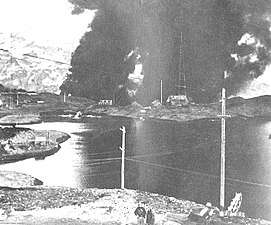
According to Japanese intelligence, the nearest field for land-based American aircraft was at Fort Morrow AAF on Kodiak, more than 600 miles (970 km) away, and Dutch Harbor was a sitting duck for the strong Japanese fleet, carrying out a coordinated operation with a fleet that was to capture Midway Island.
Making use of weather cover, the Japanese made a two-day aerial bombing of the continental United States for the first time in history on Dutch Harbor in the city of Unalaska, Alaska on June 3, 1942. The striking force was composed of Nakajima B5N2 "Kate" torpedo bombers from the carriers Junyō and Ryūjō. However, only half of the striking force reached their objective.[9] The rest either became lost in the fog and darkness and crashed into the sea or returned to their carriers. Seventeen Japanese planes found the naval base, the first arriving at 05:45. As the Japanese pilots looked for targets to engage, they came under intense anti-aircraft fire and soon found themselves confronted by Eleventh Air Force fighters sent from Fort Glenn Army Air Field on Umnak. Startled by the American response, the Japanese quickly released their bombs, made a cursory strafing run, and left to return to their carriers. As a result, they did little damage to the base.
On June 4, the Japanese returned to Dutch Harbor. This time, the Japanese pilots were better organized and prepared. When the attack ended that afternoon Dutch Harbor oil storage tanks were burning, the hospital partly demolished, and a beached barracks ship damaged. Although American pilots eventually located the Japanese carriers, attempts to sink the ships failed due to bad weather setting in that caused the U.S. pilots to completely lose contact with the Japanese fleet. However, the foul weather caused the Japanese to cancel plans to invade Adak with 1,200 men.[10]
Invasion of Kiska and Attu
Main articles: Japanese occupation of Kiska and Japanese occupation of Attu
The Japanese invasions and occupations of Kiska on June 6 and Attu on June 7 shocked the American public, as the continental United States was invaded for the first time since the War of 1812. The invading forces initially met little resistance from the local Unangax, also known as Aleuts. Though the U.S. Navy had offered to evacuate Attu in May 1942,[11] the Attuan Unangax chief declined. Little changed for the Unangax under Japanese occupation until September 1942 when Japan's Aleutian strategy shifted. It was at this point that the Unangax were taken to Hokkaido, Japan and placed in an internment camp.
The invasion of Attu and imprisonment of the local Unangax became the justification for the United States' own policy of forcible evacuation of the Unangax in the Aleutian Islands. Unangan civilians were placed in internment camps in the Alaska Panhandle.
Allied response

Many Americans feared that the Japanese would use the islands as bases to strike within range along the rest of the United States West Coast. Although the U.S. West Coast was subject to attack several times in the past six months (including unrestricted submarine warfare in coastal waters and the bombardment of Ellwood in Santa Barbara, California), the Aleutians Islands Campaign of June 1942 was the first major operation by a foreign enemy in the American Theater of the war. Lieutenant Paul Bishop of the 28th Bombardment Group once recalled that:
General Simon B. Buckner Jr. [of the Alaska Defense Command] said to us that the Japanese would have the opportunity to set up airbases in the Aleutians, making coastal cities like Anchorage, Seattle, and San Francisco vulnerable within range to attack by their bombers. The fear of that scenario was real at the time because the Japanese were nearly invincible and ruthless in Asia and the Pacific. We knew that they bombed China relentlessly and by surprise on Pearl Harbor, so we had to make sure it wouldn't happen here in the continental U.S. similar to what the Germans did over London and Coventry.[12]
Lt. Bob Brocklehurst of the 18th Fighter Squadron also said that:
[T]he impression we were given — and this was voiced oral stuff — was that we had nothing to stop the Japanese. [Our commanding officers] figured that the Japanese, if they wanted to, could have come up the Aleutians, taken Anchorage, and come down past down Vancouver to Seattle, Washington.[13]
In August 1942, the USAAF established an air base on Adak Island and began bombing Japanese positions on Kiska. U.S. Navy submarines and surface ships also began patrolling the area. Kiska Harbor was the main base for Japanese ships in the campaign and several were sunk there, some by warships but mostly in air raids. On 5 July, the submarine Growler, under command of Lieutenant Commander Howard Gilmore, attacked three Japanese destroyers off Kiska. He sank one and heavily damaged the others, killing or wounding 200 Japanese sailors. Ten days later, Grunion was attacked by three Japanese submarine chasers in Kiska Harbor, with two of the patrol craft sunk and one other damaged. On 12 May 1943, the Japanese submarine I-31 was sunk in a surface action with the destroyer Edwards 5 mi (4.3 nmi; 8.0 km) northeast of Chichagof Harbor.
Komandorski Islands
_in_action_during_the_Battle_of_the_Komandorski_Islands_on_26_March_1943_(80-G-73827).jpg)
A cruiser and destroyer force under Rear Admiral Charles "Soc" McMorris was assigned to eliminate the Japanese supply convoys. They met the Japanese fleet in the naval Battle of the Komandorski Islands in March 1943. One American cruiser and two destroyers were damaged, with seven U.S. sailors killed. Two Japanese cruisers were damaged, with 14 men killed and 26 wounded. Japan thereafter abandoned all attempts to resupply the Aleutian garrisons by surface vessels, and only submarines would be used.
Attu Island
On 11 May 1943, American forces commenced an operation to recapture Attu ("Operation Landcrab"). The invasion force included scouts recruited from Alaska, nicknamed Castner's Cutthroats. A shortage of landing craft, unsuitable beaches, and equipment that failed to operate in the appalling weather made it difficult for the Americans to exert force against the Japanese.
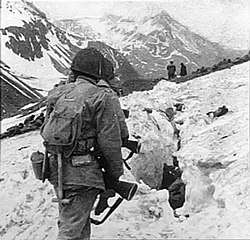
Adding to problems for the U.S. forces, soldiers suffered from frostbite because essential cold-weather supplies could not be landed, nor could soldiers be relocated to where they were needed, because vehicles could not operate on the tundra. The Japanese defensive strategy against the American attacks included Colonel Yasuyo Yamasaki having his forces engage the Americans not where they landed, as might have been expected, but rather, the Japanese dug into high ground far from the shore. This resulted in fierce combat, with a total of 3,929 U.S. casualties: 549 men were killed, 1,148 were wounded, with another 1,200 men suffering severe injuries from the cold weather. In addition, 614 Americans died from disease, and 318 from miscellaneous causes, mainly Japanese booby traps or friendly fire.
On May 29, 1943, without warning the remainder of Japanese forces attacked near Massacre Bay. This was recorded as one of the largest banzai charges of the Pacific campaign. Led again by Colonel Yamasaki, the attack penetrated so deep into U.S. lines that Japanese soldiers encountered rear-echelon units of the Americans. After furious, brutal, often hand-to-hand combat, the Japanese force was virtually exterminated. Only 28 Japanese soldiers were taken prisoner, none of them officers. American burial teams counted 2,351 Japanese dead, but it was thought that hundreds more Japanese bodies had been buried by bombardment during the battle.[14]
Kiska Island
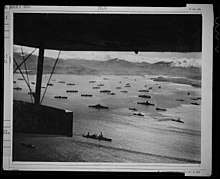
On 15 August 1943, an invasion force of 34,426 Canadian and American troops landed on Kiska. Castner's Cutthroats were part of the force, but the invasion consisted mainly of units from the U.S. 7th Infantry Division. The force also included about 5,300 Canadians, mostly from the 13th Canadian Infantry Brigade of the 6th Canadian Infantry Division, and the 1st Special Service Force, later known as the "Devil's Brigade," a 2,000-strong Canadian-American commando unit formed in 1942 in Montana and trained in winter warfare techniques. The Brigade included three regiments: the 1st was to go ashore in the first wave at Kiska Harbor, the 2nd was to be held in reserve to parachute where needed, and the 3rd was to land on the north side of Kiska on the second day of the assault.[15][16] The 87th Regiment of the 10th Mountain Division, the only major U.S. force specifically trained for mountain warfare, was also part of the operation.
Royal Canadian Air Force No. 111 and No. 14 Squadrons saw active service in the Aleutian skies and scored at least one aerial kill on a Japanese aircraft. Additionally, three Canadian armed merchant cruisers and two corvettes served in the Aleutian campaign but did not encounter enemy forces.
The invaders landed to find the island abandoned; the Japanese forces had left two weeks earlier. Under the cover of fog, the Japanese had successfully removed their troops on 28 July. Despite US military command having access to Japanese ciphers and having decoded all the Japanese naval messages, the Army Air Forces chose to bomb abandoned positions for almost three weeks. The day before the withdrawal, the U.S. Navy fought an inconclusive and possibly meaningless Battle of the Pips 80 mi (70 nmi; 130 km) to the west.
Although the Japanese troops had gone, Allied casualties on Kiska numbered 313. They were the result of friendly fire, booby traps, disease, mines, timed bombs set by the Japanese, vehicle accidents or frostbite. Like Attu, Kiska offered an extremely hostile environment.
Aftermath
The loyal courage, vigorous energy and determined fortitude of our armed forces in Alaska—on land, in the air and on the water—have turned back the tide of Japanese invasion, ejected the enemy from our shores and made a fortress of our last frontier. But this is only the beginning. We have opened the road to Tokyo; the shortest, most direct and most devastating to our enemies. May we soon travel that road to victory.
— Lieutenant General Simon Bolivar Buckner Jr., a few months after the Aleutian Islands Campaign[17]
Although plans were drawn up for attacking northern Japan, they were not executed. Over 1,500 sorties were flown against the Kuriles before the end of the war, including the Japanese base of Paramushir, diverting 500 Japanese planes and 41,000 ground troops.
The battle also marked the first time Canadian conscripts were sent to a combat zone in World War II. The government had pledged not to send draftees "overseas", which it defined as being outside North America. The Aleutians were considered to be North American soil, thus enabling the Canadian government to deploy conscripts without breaking its pledge. There were cases of desertion before the brigade sailed for the Aleutians. In late 1944, the government changed its policy on draftees and sent 16,000 conscripts to Europe to take part in the fighting.[18]
The battle also marked the first combat deployment of the 1st Special Service Force, though they also did not see any action.
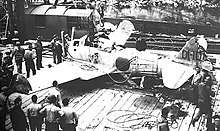
In the summer of 1942, the Americans recovered the Akutan Zero, an almost intact Mitsubishi A6M2 Zero fighter. This enabled the Americans to test-fly the Zero and contributed to improved fighter tactics later in the war.
Killed in action
During the campaign, two cemeteries were established on Attu to bury those killed in action: Little Falls Cemetery, located at the foot of Gilbert Ridge, and Holtz Bay Cemetery, which held the graves of Northern Landing Forces. After the war, the frozen tundra began to take back the cemeteries, so in 1946 all American remains were relocated as directed by the soldier's family or to Fort Richardson near Anchorage, Alaska. On May 30, 1946, a Memorial Day address was given by Captain Adair with a 21-gun salute and the sounding of Taps. The Decoration of Graves was performed by Chaplains Meaney and Insko.[19]
Veterans
The 2006 documentary film Red White Black & Blue features two veterans of the Attu Island campaign, Bill Jones and Andy Petrus. It is directed by Tom Putnam and debuted at the 2006 Locarno International Film Festival in Locarno, Switzerland, on August 4, 2006.
Dashiell Hammett spent most of World War II as an Army sergeant in the Aleutian Islands, where he edited an Army newspaper. He came out of the war suffering from emphysema. As a corporal in 1943, he co-authored The Battle of the Aleutians with Cpl. Robert Colodny under the direction of Infantry Intelligence Officer Major Henry W. Hall.
Legacy
Many of the United States locations involved in the campaign, either directly or indirectly, have been listed on the National Register of Historic Places, and several have been designated National Historic Landmarks. The battlefield on Attu and the Japanese occupation site on Kiska are both National Historic Landmarks and are included in the Aleutian Islands World War II National Monument. Surviving elements of the military bases at Adak, Umnak, and Dutch Harbor are National Historic Landmarks. The shipwrecked SS Northwestern, badly damaged during the attack on Dutch Harbor, is listed on the National Register, as is a crash-landed B-24D Liberator on Atka Island.
See also
- Aleut Restitution Act of 1988
- American Theater (World War II)
- Castner's Cutthroats
- Japanese occupation of Attu
- Japanese occupation of Kiska
- Military history of the Aleutian Islands
- Organization of the Imperial Japanese Navy Alaskan Strike Group
- Paul Nobuo Tatsuguchi, Japanese doctor stationed on Attu
- Report from the Aleutians, a 1943 American documentary propaganda film about the campaign, directed by John Huston
References
Notes
- Cloe 1990, pp. 321–323
- MacGarrigle, George L. Aleutian Islands. The U.S. Army Campaigns of World War II. United States Army Center of Military History. CMH Pub 72-6.
- History.com Editors. "Battle of the Aleutian Islands". HISTORY. Retrieved January 31, 2019.
- Pike, Francis (2016). Hirohito's War: The Pacific War, 1941–1945. London: Bloomsbury Publishing. p. 1003. ISBN 978-1-350-02122-8.
- John Haile Cloe. "Attu: The Forgotten Battle" (PDF). National Park Service.
Most people are unaware that the United States launched its first offensive operations in the Pacific with the Aleutian Campaign, June 1942-August 1943. It preceded landing on Guadalcanal by two months.
- Compare: "Battle for the Aleutians: WWII's Forgotten Alaskan Campaign". history.com.
[...] considered a sideshow to the more high-profile battles in the South Pacific, the Aleutians campaign was a vital early victory for the United States.
- Parshall, Jonathan; Anthony Tully (2005). Shattered Sword: The Untold Story of the Battle of Midway. Potomac Books. ISBN 978-1-57488-924-6.
- http://www.navweaps.com/index_oob/OOB_WWII_Pacific/OOB_WWII_Midway.htm, and http://www.ibiblio.org/hyperwar/USN/Aleutians/USN-CN-Aleutians-3.html#page22, accessed November 2011
- Banks, Scott (April/May 2003)."Empire of the Winds Archived August 30, 2008, at the Wayback Machine" American Heritage. Retrieved 7-29-2010.
- Nagle, John Copeland (2010). Law's environment: how the law shapes the places we live. Yale University Press. p. 39. ISBN 978-0-300-12629-7.
- Commission on Wartime Relocation and Internment of Civilians. 1982. Personal Justice Denied. Washington, D.C.: Commission on Wartime Relocation and Internment of Civilians. Congressional Report. https://www.archives.gov/files/research/japanese-americans/justice-denied/aleuts-page-317.pdf.
- Parshall, Jonathan; Anthony Tully (2005). Shattered Sword: The Untold Story of the Battle of Midway. Potomac Books. p. 57. ISBN 978-1-57488-924-6.
- Sobel, Zoë (May 14, 2018). "Lt. Colonel Bob Brocklehurst and Tara Bourdukofsky reflect on the Battle of Attu". Alaska Public Media.
- "Armour force". Retrieved November 11, 2019.
- Adleman, Robert H.; Walton, George H. (2004). The Devil's Brigade. Naval Institute Press. pp. 103–106. ISBN 9781591140047. OCLC 53019821.
- Warner, Bret (2006). First Special Service Force 1942-44. Osprey. pp. 14–15. ISBN 9781841769684. OCLC 84991571.
- "The Battle of the Aleutians, October 1943" (PDF).
- Stacey, C. P.; Canada. Dept. of National Defence. General Staff. (1948). The Canadian Army, 1939–1945; an official historical summary. Ottawa: E. Cloutier, King's Printer. OCLC 2144853.
- "Archived copy". Archived from the original on January 21, 2010. Retrieved February 5, 2010.CS1 maint: archived copy as title (link)
Bibliography
- Cloe, John Haile (1990). The Aleutian Warriors: A History of the 11th Air Force and Fleet Air Wing 4. Missoula, Montana: Pictorial Histories Publishing Co. and Anchorage Chapter – Air Force Association. ISBN 0-929521-35-8. OCLC 25370916.CS1 maint: ref=harv (link)
- Cohen, Stan (1981). The Forgotten War: A Pictorial History of World War II in Alaska and Northwestern Canada (Volumes 1-3). Missoula, Montana: Pictorial Histories Publishing Co., Inc. ISBN 0-933126-13-1.
- Dickrell, Jeff (2001). Center of the Storm: The Bombing of Dutch Harbor and the Experience of Patrol Wing Four in the Aleutians, Summer 1942. Missoula, Montana: Pictorial Histories Publishing Co., Inc. ISBN 1-57510-092-4. OCLC 50242148.
- Feinberg, Leonard (1992). Where the Williwaw Blows: The Aleutian Islands-World War II. Pilgrims' Process. ISBN 0-9710609-8-3. OCLC 57146667.
- Garfield, Brian (1995) [1969]. The Thousand-Mile War: World War II in Alaska and the Aleutians. Fairbanks: University of Alaska Press. ISBN 0-912006-83-8. OCLC 33358488.
- Goldstein, Donald M.; Dillon, Katherine V. (1992). The Williwaw War: The Arkansas National Guard in the Aleutians in World War. Fayetteville: University of Arkansas Press. ISBN 1-55728-242-0. OCLC 24912734.
- Hays, Otis (2004). Alaska's Hidden Wars: Secret Campaigns on the North Pacific Rim. University of Alaska Press. ISBN 1-889963-64-X.
- Lorelli, John A. (1984). The Battle of the Komandorski Islands. Annapolis: United States Naval Institute. ISBN 0-87021-093-9. OCLC 10824413.
- MacGarrigle, George L.; Center of Military History (1992). Aleutian Islands. Government Printing Office. ISBN 978-0-16-035882-1.
- Morison, Samuel Eliot (2001) [1951]. Aleutians, Gilberts and Marshalls, June 1942 – April 1944, vol. 7 of History of United States Naval Operations in World War II. Champaign: University of Illinois Press. ISBN 0-316-58305-7. OCLC 7288530.
- Parshall, Jonathan; Tully, Anthony (2005). Shattered Sword: The Untold Story of the Battle of Midway. Dulles, Virginia: Potomac Books. ISBN 1-57488-923-0. OCLC 60373935.
- Perras, Galen Roger (2003). Stepping Stones to Nowhere, The Aleutian Islands, Alaska, and American Military Strategy, 1867–1945. Vancouver: University of British Columbia Press. ISBN 1-59114-836-7. OCLC 53015264.
- Urwin, Gregory J. W. (2000). The Capture of Attu: A World War II Battle as Told by the Men Who Fought There. Bison Books. ISBN 0-8032-9557-X.
- Wetterhahn, Ralph (2004). The Last Flight of Bomber 31: Harrowing Tales of American and Japanese Pilots Who Fought World War II's Arctic Air Campaign. Da Capo Press. ISBN 0-7867-1360-7.
- Zaloga, Steven J. (2007). Japanese Tanks 1939–45. Osprey. ISBN 978-1-84603-091-8.
Further reading
- Vidal, Gore (1946), Williwaw, New York: E. P. Dutton.
External links
| Wikimedia Commons has media related to Aleutian Islands campaign. |
- Logistics Problems on Attu by Robert E. Burks.
- The short film "Operations at Amchitka, Attacks on Attu" is available for free download at the Internet Archive
- Aleutian Islands Chronology
- Aleutian Islands War
- Red White Black & Blue – feature documentary about The Battle of Attu in the Aleutians during World War II
- PBS Independent Lens presentation of Red White Black & Blue – The Making Of and other resources
- ”Attu: North American Battleground of World War II”, a National Park Service Teaching with Historic Places (TwHP) lesson plan
- Animated Maps of the Aleutians Campaign
- Attu, Aleutian Islands, Alaska WW-II KIA
- US losses at Kiska
